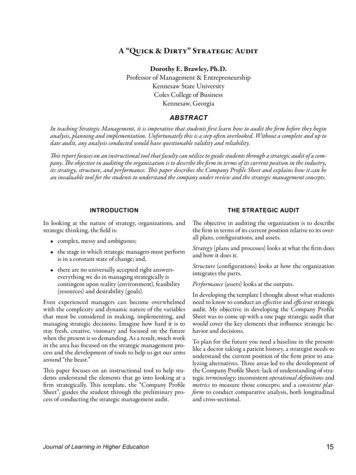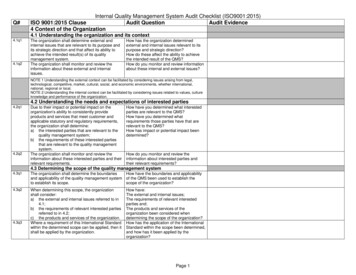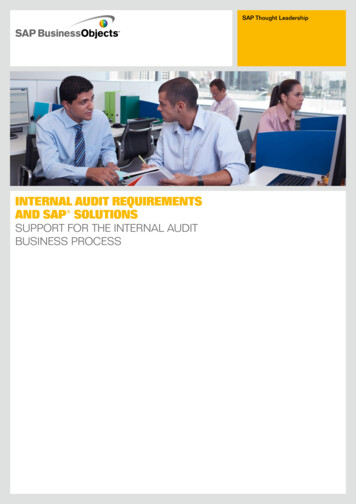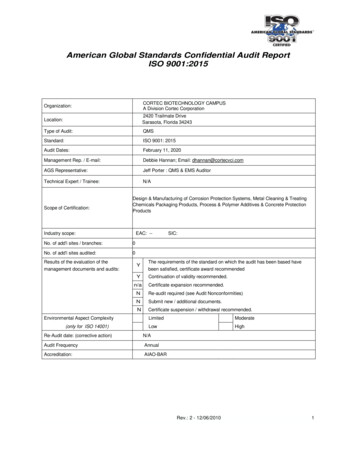
Transcription
A “Quick & Dirty” Strategic AuditDorothy E. Brawley, Ph.D.Professor of Management & EntrepreneurshipKennesaw State UniversityColes College of BusinessKennesaw, GeorgiaABSTRACTIn teaching Strategic Management, it is imperative that students first learn how to audit the firm before they beginanalysis, planning and implementation. Unfortunately this is a step often overlooked. Without a complete and up todate audit, any analysis conducted would have questionable validity and reliability.This report focuses on an instructional tool that faculty can utilize to guide students through a strategic audit of a company. The objective in auditing the organization is to describe the firm in terms of its current position in the industry,its strategy, structure, and performance. This paper describes the Company Profile Sheet and explains how it can bean invaluable tool for the students to understand the company under review and the strategic management concepts.INTRODUCTIONTHE STRATEGIC AUDITIn looking at the nature of strategy, organizations, andstrategic thinking, the field is:The objective in auditing the organization is to describethe firm in terms of its current position relative to its overall plans, configurations, and assets. complex, messy and ambiguous; the stage in which strategic managers must performis in a constant state of change; and, there are no universally accepted right answerseverything we do in managing strategically iscontingent upon reality (environment), feasibility(resources) and desirability (goals).Even experienced managers can become overwhelmedwith the complexity and dynamic nature of the variablesthat must be considered in making, implementing, andmanaging strategic decisions. Imagine how hard it is tostay fresh, creative, visionary and focused on the futurewhen the present is so demanding. As a result, much workin the area has focused on the strategic management process and the development of tools to help us get our armsaround “the beast.”This paper focuses on an instructional tool to help students understand the elements that go into looking at afirm strategically. This template, the “Company ProfileSheet”, guides the student through the preliminary process of conducting the strategic management audit.Journal of Learning in Higher EducationStrategy (plans and processes) looks at what the firm doesand how it does it.Structure (configurations) looks at how the organizationintegrates the parts.Performance (assets) looks at the outputs.In developing the template I thought about what studentsneed to know to conduct an effective and efficient strategicaudit. My objective in developing the Company ProfileSheet was to come up with a one page strategic audit thatwould cover the key elements that influence strategic behavior and decisions.To plan for the future you need a baseline in the presentlike a doctor taking a patient history, a strategist needs tounderstand the current position of the firm prior to analyzing alternatives. Three areas led to the development ofthe Company Profile Sheet: lack of understanding of strategic terminology; inconsistent operational definitions andmetrics to measure those concepts; and a consistent platform to conduct comparative analysis, both longitudinaland cross-sectional.15
Dorothy E. BrawleyTERMINOLOGYStrategic Management is usually taken at the end of theprogram of study in business—the capstone experience.Although students taking this course have been exposedto the basic concepts of business in their core courses(Management, Accounting, Finance, Marketing, Economics, Information Systems), their ability to apply thoseconcepts in an integrative way into a company study islimited. Because of the dynamic and complex nature ofthe field of strategy there are many concepts and variablesstudents must consider in conducting a strategic audit of afirm. Exposure to such concepts as company demographicssector, trading, company type, industry classification, distribution areas tend to be abstract concepts, not groundedin application. Strategic concepts including corporate/business/functional level strategies, structural forms, andprocess strategies tend to be new variables to students,covered superficially in earlier courses but forgotten. Performance indicators including an ability to really look atbalance sheets, income statements and ratios, analyzedand memorized for tests in earlier courses, have long beenput aside as unimportant.Additionally, students tend to have been exposed to textcases, where data is available in a concise, problem specificcontext. Reality is not written like a textbook case. Asking students to learn to pull current data from real company documents like the annual reports and 10k may be anew experience for them.OPERATIONAL DEFINITIONS AND METRICSIt is one thing to be exposed to the concepts—it is anotherto understand the metrics required to operationalize thoseconcepts. Most Strategic Management texts give theoretical definitions of terminology. My objective in developingthe template with definitional instructions was to give thestudents a guide with operational metrics for each of thevariables under audit.CONSISTENT PLATFORMThe template provides a consistent platform for conducting a strategic audit. It serves as a map that guides the student throughthe key elements of the audit. It provides an integrative approach to strategicaudit versus disjointed presentation of concepts. It provides the ability to examine not only a singlecompany, but to conduct longitudinal and crosssectional company comparisons using an integrative template for data collection.16A “QUICK & DIRTY” STRATEGIC AUDIT It provides a foundation for more in-depth andqualitative narratives of strategy. It serves as a complement to case analysis.THE COMPANY PROFILE SHEETThe Company Profile Sheet, Appendix A, provides a“quick and dirty” strategic snap shot of the firm. The company profile sheet is divided into three primary sectionsand is composed of 34 questions. Primary data can coverthe most current year, but to really understand strategicchange, it is good to look at data over several years.The first section (items 1-10) includes general information on the firm: its name, address, phone number, trading name/ symbol/ markets, industry classification, datesfounded/ incorporated/ public, sector, industry type, distribution areas, key subsidiaries, outlets, and employees.The second section of template is Strategy, Structure information, items 11-18. Once you have collected generaldemographic data on the firm, you can begin to dig deeperinto the strategy and structural configurations: businessdescription, identifiable businesses, strategy of growthclassification (single business or multi), competitive strategy, primary markets/ products/ brands, integration (vertical or horizontal), process of growth classification, andstructure.The third section of the profile includes performanceinformation (items 19-34). Taking information from theincome statement, balance sheet and key ratios this provides a quick look into financial standing of the firm. Performance looks at the outputs. A strategic manager mustlook at the financial numbers in order to understand whatis going on in the company. It is critical that the studentlearn to appreciate and “love” the numbers in order to develop effective strategy.DATA COLLECTIONGuiding students in data collection is the first step in thestrategic audit process. Begin with documentary publications and self-reported firm information. If the firm under investigation is traded publically, have your studentsbegin their research by reviewing the documents filedwith the SEC-the annual report, the 10K, and proxy statements. Original company documents provide the cleanestinformation on the firm, and the pictures, letters, and narratives provide some insight into the company character,values and image. The company website and investor presentations provide essential information to understanding the company strategy, goals and performance. Thecompany profile sheet can also help the students to focusinterview questions when collecting primary data.Fall 2016 (Volume 12 Issue 2)Figure 1Company Profile Sheet-General InformationGENERAL INFORMATIONwww email1.Firm NameAddressPhone2.Trading Name/SymbolTrading Markets (AMEX NYSE OTC)3.SIC Numbers4.Sector (Manufacturing; Service (includes retail, wholesale, distribution); Mining/Oil/Gas; Combined)5.Date foundedincorporatedpublic6.Industry Type (Science based; Non Science) 7.Distribution areas (Local; regional; national; international (%)8.Key Subsidiaries9.Number of outlets10.Number of full-time employees 20XX (n-1)20XX(n)**(n current year; n-1 last year)Figure 2Company Profile Sheet-Strategy & Structure InformationSTRATEGY, STRUCTURE INFORMATION11.Business Description12.Identifiable Businesses (Corporate)(SQ-G-R-L)13.Strategy of Growth: (Single Business (Single line; Dominant);Multi-business (Related; n Ratio Rev.largest discrete bus./total revenues:Relatedness Ratio Rev.largest group discrete bus./total rev:13b.strategy of growth classification20XX(n-1) 20XX(n)Single Business Single line (SR .95)1.11.1Dominant (.7 SR .95)1.21.2Multi-BusinessRelated (RR .7)2.32.3Unrelated (RR .7)2.42.414.Competitive Strategy (Business) Segment(ADRF) Cost leadership or DifferentiationMarket Focus: Narrow or Broad15.Primary MarketsPrimary grationVertical and /or Horizontal17.Process of GrowthInternal Development and/ or External Process (Acquisitions, Mergers, Joint Ventures, Strategic Divisional22Type 20XX(n) (product, geographic, holding, other)Other33Identify20XX(n)B2B and/or B2CFigure 3Company Profile Sheet-PerformancePERFORMANCE ( OOOXXX)20XX(n-1)(Conversion rate: 1USD )20XX(n)19. Net Revenues20. Net Income28. Net Income/Revenue(profitability)21. EPS29. ROC(profitability)22. # Shares30. D/E(leverage)23. Stock Price31. Working Capital(liquidity)24. Dividends32. Marketing Expense25. Total Assets33. R&D Expense26. Long TermDebt34. PatentsOn the first day of class I give the Company Profile Sheetalong with the instructions to the students. I assign aspecific company to audit, so all students are working onthe same case. (I refer to “real company analysis” as “ live”cases). I usually pick a publically held firm where on-lineaccess to the Annual Report/10K is available. Their assignment is to complete the template as much as they canover the week, recognizing that we have not yet coveredthe material in class. This gives a baseline of what theycurrently know. When we come back to class I put themin teams and give them time to compare their work, andagain complete the assignment as much as they can as aJournal of Learning in Higher Education20XX(n-1)20XX(n)27. P/E Ratio (date)team. At this point students discover they “knew morethan they thought they knew” and they have begun tolearn how to draw information from real company documents. At this point students can begin collecting thedata for their individual company reports on firms theychose. Over the next month together we cover line by linethe concepts in the Company Profile Sheet. By the timewe have completed reviewing the 34 questions, we havecovered most of the concepts in Strategic Managementcorporate, business, and functional level strategy.17
Dorothy E. BrawleyA “QUICK & DIRTY” STRATEGIC AUDITI recommend that students be consistent in how they present data from a strategic perspective. Strategists read left toright, so it makes sense to present the data in that format(unlike the way Accountants present data). I recommendusing annual data. When students mix quarterly and annualized data, everything gets confused. Another observation is that students have a hard time getting the unitson the performance measures correct and consistent. Moreoften than I would like to admit they think the companyrevenues are in the trillions!Appendix B includes the instructions to guide the students in collecting the data and filling out the sheet, itemby item. Upon completion of the data collection in thetemplate, your students will have created a one page, indepth strategic audit of the firm.SUMMARYCompleting the Company Profile Sheet is the first step inthe strategic audit and provides a “quick and dirty” strategic snapshot of the firm. It highlights general companyinformation, strategy and structure information, andperformance information on one concise and integratedpage. Page two of the sheet provides additional information on the company description, a breakout of its strategic segments including revenue and operating incomeby segment, and structure in support of the classificationson page 1. This sheet can be an extremely effective tool inhelping the student in a strategic management course, ora business person, to get their “arms around the beast” wecall Strategic Management, and can serve as a first step inconducting a strategic analysis of the firm.I have found using the Company Profile Sheet assignmenthelps the students in their final term to be exposed to real companies, with real data, inreal time; to understand how to search out data on real companies using documents that are readily availableoutside of a textbook and outside of the universityresources; to improve their confidence about what they havereally learned in their program of study; to help them understand the integrative nature ofthe concepts; to establish meaningful discussion of strategy andbusiness based on consistent terminology and operational metrics versus anecdotal stories; to collect data on companies they are interviewingor work with-and,18 to understand some key questions to ask whenconsidering a potential company opportunity.I have found using the Company Profile Sheet assignmenthelps the faculty structure class discussions using the template as afoundation for teaching strategic concepts; makes it easier to evaluate student work because itfollows a consistent, standardized format;PepsiCo, Inc. (FYE 12/31:1993). 10K, ml (May 5,2015)PepsiCo, Inc. (FYE 12/31:2014). 10K. http://www.pepsico.com/Investors/SEC-Filings (September 29,2016)URFU0M9U0VDVElPTl9FTlRJUkUmc3Vic2lkPTU3, (May 5, 2015)Time Warner, Inc. Organization Chart. ner (May 5,2015).Time Warner, Inc. (FYE 12/31:2014). 10K, http://ir.timewarner.com/phoenix.zhtml?c 70972&p irolSECText&TEXT lwYWdlPTEwMTAzNzQ3JkRTRVE9MCZTRVE9MCZTU- helps ensure that key concepts are covered and notforgotten; highlights the importance of doing a critical strategic audit prior to analysis and planning. Also, I have each student pick a different companyto audit and as a result, I am exposed to many newand different firms I would not normally revieweach term. The template could also serve as a research platformfor data collection for faculty conducting longitudinal and/or cross sectional company analysis.A completed sample Company Profile Sheet for TimeWarner, Inc. is included in Appendix C.REFERENCESBrawley, D. & Desman, R. (2011). Strategy in 3 dimensions: A blueprint for effective planning, implementation, & control. Revised unpublished manuscript.Coca Cola Company.(FYE 12/31:1993).10K, okeannual.pdf (May 5, 2015)TO: Coca Cola Company.(FYE 12/31:2015).10K. alreport-on-form-10-k.pdf (September 29,2016)NAICS codes that constitute high-technology ndex.cfm/chapter-8/c8s6o55.htm (May 5, 2015)Porter, M. (1985). Competitive advantage. New York: FreePress.Rumelt, R. (1974). Strategy, structure, and economic performance. Division of Research, Harvard BusinessSchool, Boston, MA.SIC/NAICS Codes. http://siccode.com/en (May 5, 2015)Fall 2016 (Volume 12 Issue 2)Journal of Learning in Higher Education19
Dorothy E. BrawleyA “QUICK & DIRTY” STRATEGIC AUDITAPPENDIX ACompany Profile SheetExhibit 1.1 Strategic AuditAPPENDIX BCompany Profile Sheet InstructionsRater NameThe Company Profile Sheet, Appendix A, provides a“quick and dirty” strategic snap shot of the firm. Theobjective in completing the company profile sheet is tobriefly describe the firm in terms of its overall strategy,structure, and performance. Data collection is the firststep in the strategic audit process. Begin with documentary publications and self-reported firm information. If the firm under investigation is traded publicly,begin your research by reviewing the documents filedwith the SEC---the annual report, the 10K, and proxystatements. Original company documents provide thecleanest information on the firm, and the pictures, letters, and narratives provide some insight into the company character and image. These filings are availableupon request from the company, in most universityand public libraries, and can also be retrieved on manyon-line databasesDate3-D COMPANY PROFILE SHEETSTRATEGY, STRUCTURE, AND PERFORMANCEGENERAL INFORMATIONwww email1.Firm NameAddressPhone2.Trading Name/SymbolTrading Markets (AMEX NYSE OTC)3.SIC Numbers4.Sector (Manufacturing; Service (includes retail, wholesale, distribution); Mining/Oil/Gas; Combined)5.Date foundedincorporatedpublic6.Industry Type (Science based; Non Science)7.Distribution areas (Local; regional; national; international (%)8.Key Subsidiaries9.Number of outlets10.Number of full-time employees 20XX (n-1)20XX(n)**(n current year; n-1 last year)STRATEGY, STRUCTURE INFORMATION11.Business Description12.Identifiable Businesses (Corporate)(SQ-G-R-L)13.Strategy of Growth: (Single Business (Single line; Dominant);Multi-business (Related; lization Ratio Rev.largest discrete bus./total revenues:Relatedness Ratio Rev.largest group discrete bus./total rev:13b.strategy of growth classification20XX(n-1)20XX(n)Single BusinessSingle line (SR .95)1.11.1Dominant (.7 SR .95)1.21.2Multi-BusinessRelated (RR .7)2.32.3Unrelated (RR .7)2.42.414.Competitive Strategy (Business) Segment(ADRF) Cost leadership or DifferentiationMarket Focus: Narrow or BroadB2B and/or B2C15.Primary MarketsPrimary grationVertical and /or Horizontal17.Process of GrowthInternal Development and/ or External Process (Acquisitions, Mergers, Joint Ventures, Strategic Divisional22Type 20XX(n) (product, geographic, holding, other)Other33IdentifyPERFORMANCE ( OOOXXX)(Conversion rate: 1USD )20XX(n-1)20XX(n)20XX(n-1)20XX(n)19. Net Revenues27. P/E Ratio (date)20. Net Income28. Net Income/Revenue(profitability)21. EPS29. ROC(profitability)22. # Shares30. D/E(leverage)23. Stock Price31. Working Capital(liquidity)24. Dividends32. Marketing Expense25. Total Assets33. R&D Expense26. Long TermDebt34. PatentsGENERAL INFORMATION:1. Firm Name, Website, Email, Address, Telephone NumberAs you begin your research it is very important to makesure you have the correct firm name. Many firms havenames that are very similar---for example, Coca ColaCompany, Coca Cola Enterprises, Coca Cola BottlingCompany, Coca Cola USA. However, each representsa distinctly different company unit. Make sure that youare collecting data on the right system.I. BUSINESS DESCRIPTIONII. STRATEGY - SEGMENT INFORMATION (Revenue; Operating Income by Segment) 000XXX Rev20XX(n-1)%Total Rev 000XXXOp Inc%Op IncomeRevenues/Operating Income100%III. STRUCTURE - Draw it. Include position, titles and names(by segment) 000XXX RevTOTALYear 20XXnIV. FINANCIALS: Include latest Income Statement & Balance Sheet.Analyze the financials from 20XX(n-1) and 20XX
THE COMPANY PROFILE SHEET The Company Profile Sheet, , provides a Appendix A “quick and dirty” strategic snap shot of the firm. The com - pany profile sheet is divided into three primary sections and is composed of 34 question










